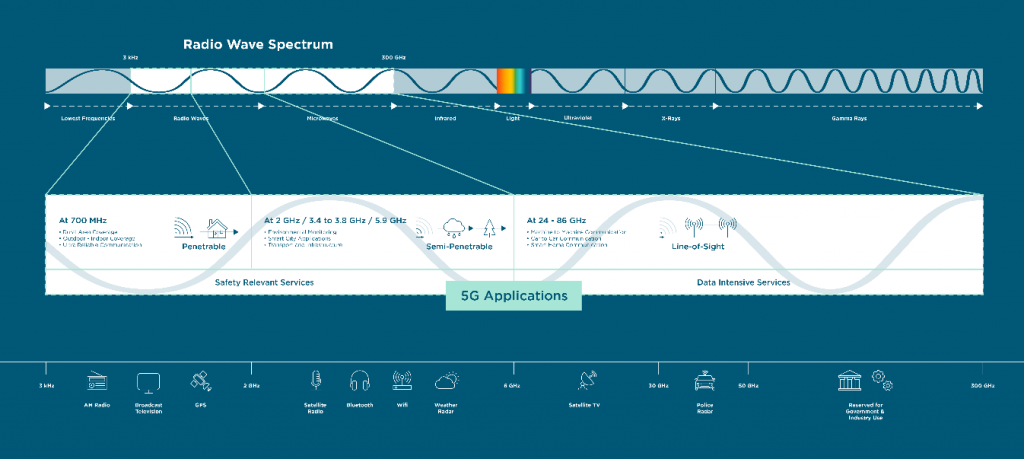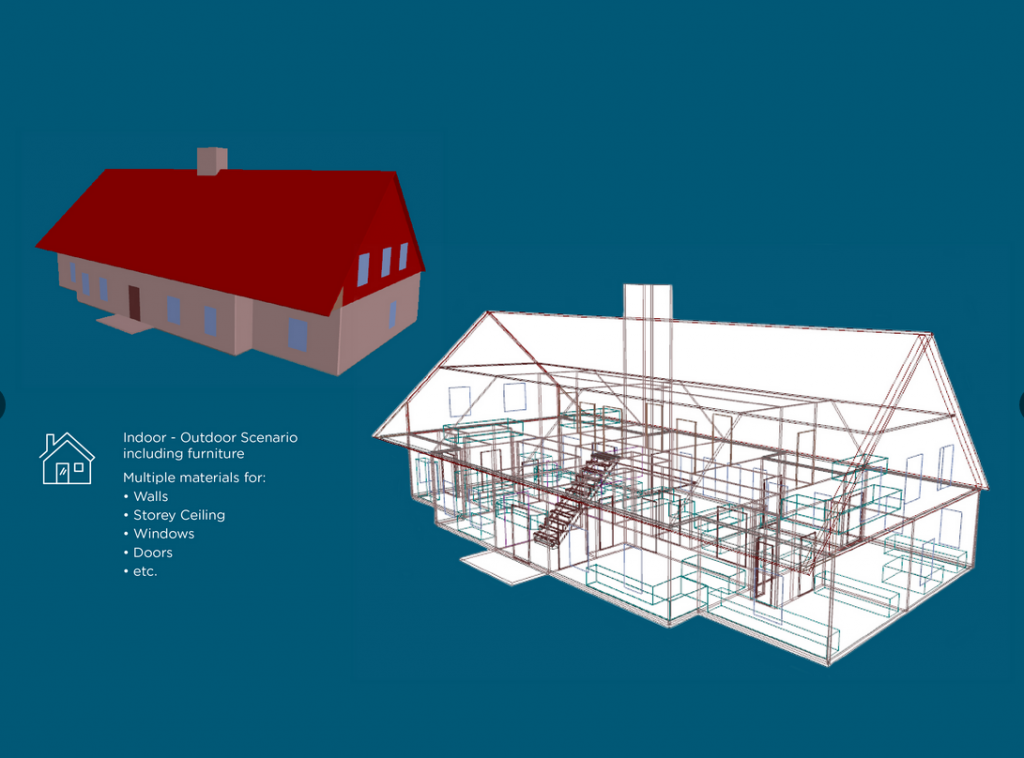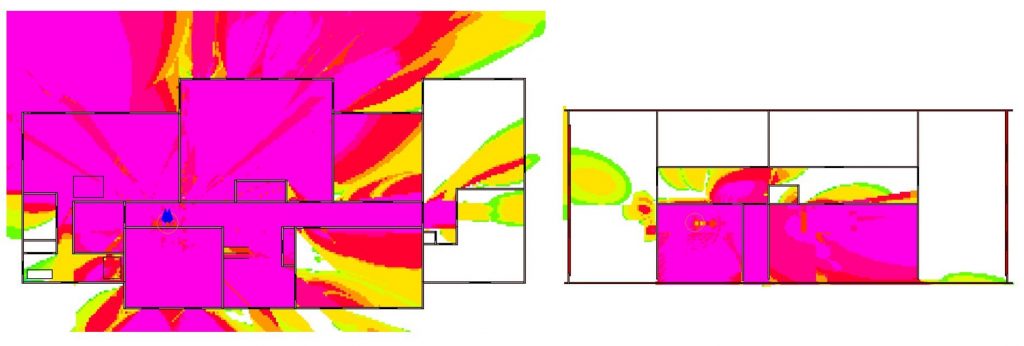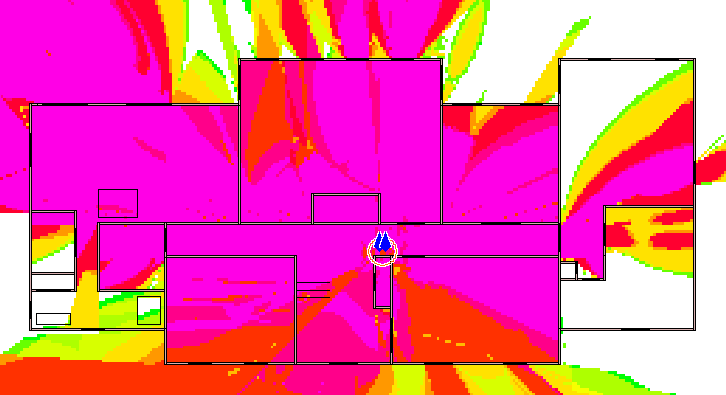The Three Little Home Schoolers and the Wi-Fi Wolf – A Private Network-Planning Exercise
When talking to colleagues who are raising teenagers, we all know that the title should instead be “The Three Little Online Gamers and the Wi-Fi Wolf,” but that is another discussion.
Have you ever lost your Wi-Fi signal during a web meeting because you needed to move your laptop from your favorite desk so it could be employed for its intended use as a kitchen table? Or when virtual learning is done for the day, and your kids turn into warriors, race drivers, or space pilots, has a poor network connection caused your meeting to end prematurely?
When homeschooling, working from home, and online gaming culminate, Wi-Fi becomes a precious commodity.
Furthermore, the high-data-rate 5GHz Wi-Fi is often not found everywhere in the house.
Analysis of the network coverage (visualizing the data rates in MBits/s) on the ground floor including the outdoor area in “northwest” corner of the building.
Analysis of the network coverage (visualizing the data rates in MBits/s) on the second floor of a building (displayed router is on the ground floor).
Just like the three little pigs fable, a stable home Wi-Fi connection has a lot to do with what material your house is made of. Before simply buying the most expensive internet plan and router, it’s important to understand the factors that impact your wireless speeds. The connection quality depends on the frequency of the router signal, the size of your house, the house’s layout, and even whether your walls are made of drywall, brick, concrete, or wood.
From a connectivity perspective, a straw construction would be beneficial, but we hope these are rare. Not surprisingly, homes made of wood or brick are the most common. As opposed to the best solution to keep the wolf out, the Wi-Fi enemy is the most stable structure – steel-reinforced concrete. The steel in the walls acts as a Faraday cage and keeps the electromagnetic waves out. So, when you work from home with others, what can you do to improve your wireless network when paper walls don't meet your standard of privacy?

Attainable data rates on the ground floor at different carrier frequencies and material variation of the building structure, considering the presence of low-level interference from routers in neighboring buildings.
Private network planning
Before you consider buying a new router or a Wi-Fi mesh network system, changing the router location or Wi-Fi band might bring harmony back to your household.
Wi-Fi runs on two different radio frequency bands – 5 GHz and 2.4 GHz. Most newer routers are dual-band and operate Wi-Fi networks on both bands. 5 GHz is newer and faster, so why would you want the old and slow 2.4 GHz?
Different things happen due to different frequencie 
With higher carrier frequencies, more information can be transmitted. Lower carrier frequencies travel further and through objects.
At 5 GHz, more data can be transmitted because more information can be packed in the same time span.
This vague statement can be quantified exactly in Altair WinProp™ a network planning tool that uses wireless standards as defined by regulatory committees. It considers conditions like minimum power required for detection and necessary signal-to-noise ratios. This example is based on the IEEE 802.11n standard and uses 2x2 MIMO.
Although data can be transmitted faster, it is more difficult for higher frequency electromagnetic waves to penetrate far into a building. For these higher frequency waves, it can be harder to move through solid objects such as walls, and the energy disperses faster in high-frequency signals than in low-frequency signals.
At 2.4 GHz, although not as much information can be transmitted per second, the signal gets farther before it deteriorates.
5 GHz is usually the band to choose for smaller areas. If your signal needs to cover a large space, or travel through dense walls before reaching you, 2.4 GHz will do a better job. As a rule of thumb, the differences can be listed like this:
| Frequency | Data speed | Distance | Penetration |
| 5 GHz | High speed | Short distance | Modest |
| 2.4 GHz | Low speed | Large distance | Good |
The same general concepts used to optimize the Wi-Fi connection in your home are also being applied by private 5G network operators. Large companies setting up their own campus networks in industrial plants, manufacturing facilities, and logistics centers need to account for signal obstructions, weather conditions, and signal frequency to ensure an efficient wireless environment. Operators of geographically limited networks can also be found in sports stadiums, hospitals, railways, and airports. Wireless standards may be different, but wireless connectivity tools like WinProp can incorporate many standards and all the necessary parameters.
Altair helps private network operators analyze and optimize 5G networks in urban, indoor, and combined urban-indoor scenarios. Leveraging integrated simulation of antennas and the network helps planners understand use cases, define infrastructure requirements, and create a usage plan to apply for the frequency spectrum. Altair helps these network operators find efficient 5G solutions and get regulatory approvals quicker.
Wi-Fi optimization project

The simulation model for the analysis allows a prediction for both the interior coverage and the outdoor facilities. The analysis considers furniture in the rooms throughout the building and allows a prediction of the outside area behind the house.
Now back to your home Wi-Fi optimization project. You know that a single router is not enough at 5 GHz, so either you use 2.4 GHz (accepting lower data rates) or you decide to add a repeater.
How can you obtain good coverage in the brick house on all floors at 5 GHz with just one repeater?
The following illustrations show the effects of changing the router locations to find an optimal configuration of a router downstairs and repeater upstairs.
Step 1: Base station moved left

Shown above are the attainable data rates on the ground floor and second floor when the base station gets moved to the left.
Results:
- Better coverage in the outdoor area at the expense of signal strength in multiple rooms on the ground floor.
- A possible location for a repeater on the upper floor naturally suggests itself.
Step 2: Add a repeater 
Now shown are the attainable data rates on the ground floor when the second floor base station is supported by an additional repeater (shown in blue).
- Dramatic improvement in one room downstairs and at least one room upstairs.
- Not perfect, but acceptable.
- Not all rooms in the house can be used for gaming.
Note: Both images show both devices. The total number of devices is two, not four. The router is always on the ground floor on the left, and the repeater on the second floor on the right.
Step 3: Move the base station right

Shown above are the attainable data rates on the ground floor and second floor when the base station is moved to the right (shown in blue).
- Good indoor coverage on the ground floor.
- Location for repeater upstairs naturally suggests itself.
Step 4: Router on the right with additional repeater upper floor

Now shown are the attainable data rates for the ground floor and second floor when the base station is moved to the right and a repeater is added.
- Downstairs: Better than step 2 (east room) at a small expense on the outdoor sitting area.
- Upstairs: Quite acceptable.
Note: Both images show both devices. The total number of devices is two, not four. The router is always on the ground floor on the right, and the repeater is on the second floor on the left.
Below is a summary of the pros and cons of the different frequencies.
2.4GHz Summary:
- Cons: Lower data rate, more susceptible to interference as nearby devices are likely using the same frequency
- Pros: Larger coverage area, better at successfully penetrating solid objects
- 2.4GHz max speed: ~110 Mbps (in this Wi-Fi example based on the IEEE 802.11n standard)
- 2.4Ghz max distance: Enough for a large multi-story house with terrace
5GHz Summary:
- Pros: Higher data rate, less susceptible to interference as there are typically fewer devices using the same frequency
- Cons: Smaller coverage area, less successful at penetrating solid objects
- 5Ghz max speed: ~220 Mbps (in this Wi-Fi example)
- 5Ghz max distance: Reasonable for a large multi-story house with terrace provided a repeater is used
After reading this article, you should now have a better idea of which frequency works best for your situation and the most suitable location to set up the router, or if adding a repeater will help.
To learn more about private network planning, particularly for complex outdoor-indoor scenarios, view our resources here or talk to an expert and let us know how we can support your next network planning project.






